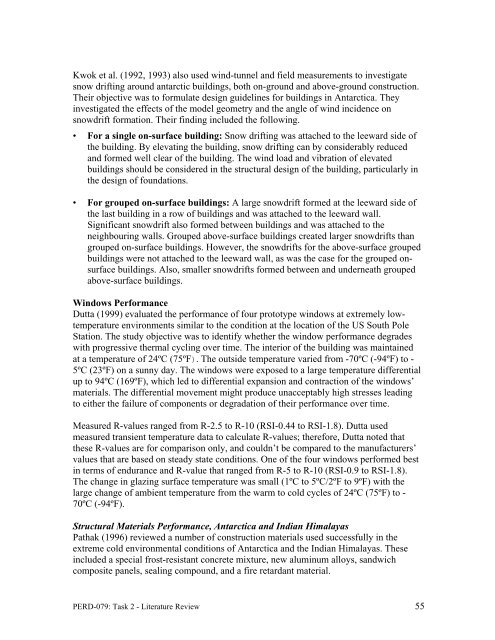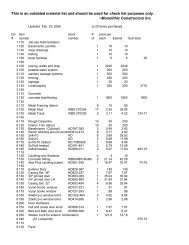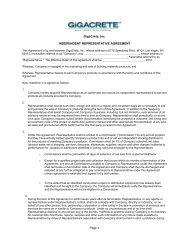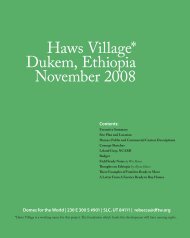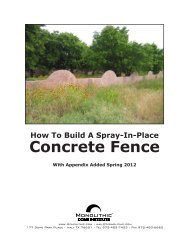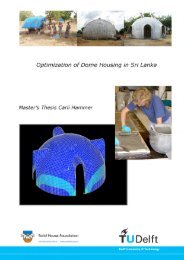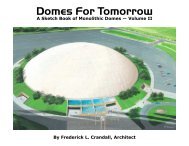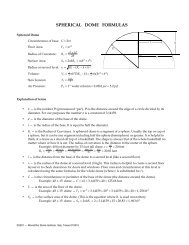Literature Review on Building Envelope, Heating and ... - Beeshive.org
Literature Review on Building Envelope, Heating and ... - Beeshive.org
Literature Review on Building Envelope, Heating and ... - Beeshive.org
Create successful ePaper yourself
Turn your PDF publications into a flip-book with our unique Google optimized e-Paper software.
Kwok et al. (1992, 1993) also used wind-tunnel <strong>and</strong> field measurements to investigate<br />
snow drifting around antarctic buildings, both <strong>on</strong>-ground <strong>and</strong> above-ground c<strong>on</strong>structi<strong>on</strong>.<br />
Their objective was to formulate design guidelines for buildings in Antarctica. They<br />
investigated the effects of the model geometry <strong>and</strong> the angle of wind incidence <strong>on</strong><br />
snowdrift formati<strong>on</strong>. Their finding included the following.<br />
• For a single <strong>on</strong>-surface building: Snow drifting was attached to the leeward side of<br />
the building. By elevating the building, snow drifting can by c<strong>on</strong>siderably reduced<br />
<strong>and</strong> formed well clear of the building. The wind load <strong>and</strong> vibrati<strong>on</strong> of elevated<br />
buildings should be c<strong>on</strong>sidered in the structural design of the building, particularly in<br />
the design of foundati<strong>on</strong>s.<br />
• For grouped <strong>on</strong>-surface buildings: A large snowdrift formed at the leeward side of<br />
the last building in a row of buildings <strong>and</strong> was attached to the leeward wall.<br />
Significant snowdrift also formed between buildings <strong>and</strong> was attached to the<br />
neighbouring walls. Grouped above-surface buildings created larger snowdrifts than<br />
grouped <strong>on</strong>-surface buildings. However, the snowdrifts for the above-surface grouped<br />
buildings were not attached to the leeward wall, as was the case for the grouped <strong>on</strong>surface<br />
buildings. Also, smaller snowdrifts formed between <strong>and</strong> underneath grouped<br />
above-surface buildings.<br />
Windows Performance<br />
Dutta (1999) evaluated the performance of four prototype windows at extremely lowtemperature<br />
envir<strong>on</strong>ments similar to the c<strong>on</strong>diti<strong>on</strong> at the locati<strong>on</strong> of the US South Pole<br />
Stati<strong>on</strong>. The study objective was to identify whether the window performance degrades<br />
with progressive thermal cycling over time. The interior of the building was maintained<br />
at a temperature of 24ºC (75ºF). The outside temperature varied from -70ºC (-94ºF) to -<br />
5ºC (23ºF) <strong>on</strong> a sunny day. The windows were exposed to a large temperature differential<br />
up to 94ºC (169ºF), which led to differential expansi<strong>on</strong> <strong>and</strong> c<strong>on</strong>tracti<strong>on</strong> of the windows’<br />
materials. The differential movement might produce unacceptably high stresses leading<br />
to either the failure of comp<strong>on</strong>ents or degradati<strong>on</strong> of their performance over time.<br />
Measured R-values ranged from R-2.5 to R-10 (RSI-0.44 to RSI-1.8). Dutta used<br />
measured transient temperature data to calculate R-values; therefore, Dutta noted that<br />
these R-values are for comparis<strong>on</strong> <strong>on</strong>ly, <strong>and</strong> couldn’t be compared to the manufacturers’<br />
values that are based <strong>on</strong> steady state c<strong>on</strong>diti<strong>on</strong>s. One of the four windows performed best<br />
in terms of endurance <strong>and</strong> R-value that ranged from R-5 to R-10 (RSI-0.9 to RSI-1.8).<br />
The change in glazing surface temperature was small (1ºC to 5ºC/2ºF to 9ºF) with the<br />
large change of ambient temperature from the warm to cold cycles of 24ºC (75ºF) to -<br />
70ºC (-94ºF).<br />
Structural Materials Performance, Antarctica <strong>and</strong> Indian Himalayas<br />
Pathak (1996) reviewed a number of c<strong>on</strong>structi<strong>on</strong> materials used successfully in the<br />
extreme cold envir<strong>on</strong>mental c<strong>on</strong>diti<strong>on</strong>s of Antarctica <strong>and</strong> the Indian Himalayas. These<br />
included a special frost-resistant c<strong>on</strong>crete mixture, new aluminum alloys, s<strong>and</strong>wich<br />
composite panels, sealing compound, <strong>and</strong> a fire retardant material.<br />
PERD-079: Task 2 - <str<strong>on</strong>g>Literature</str<strong>on</strong>g> <str<strong>on</strong>g>Review</str<strong>on</strong>g> 55


